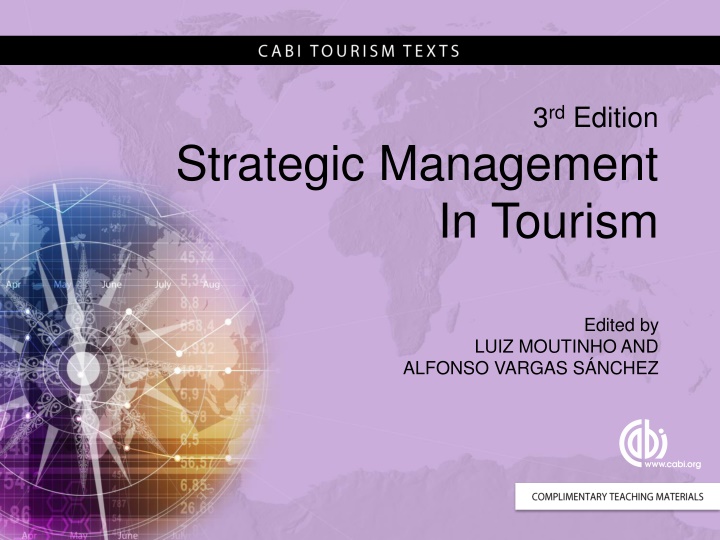
Strategic Innovation in Tourism Business: A Comprehensive Guide
Explore the strategic innovation efforts in the tourism industry, distinguishing categories of innovations, understanding the managerial choices, driving forces, and the impact of technology-driven innovations. Enhance your knowledge on how organizations can pursue changes to stay competitive and maintain an edge in the market.
Download Presentation

Please find below an Image/Link to download the presentation.
The content on the website is provided AS IS for your information and personal use only. It may not be sold, licensed, or shared on other websites without obtaining consent from the author. If you encounter any issues during the download, it is possible that the publisher has removed the file from their server.
You are allowed to download the files provided on this website for personal or commercial use, subject to the condition that they are used lawfully. All files are the property of their respective owners.
The content on the website is provided AS IS for your information and personal use only. It may not be sold, licensed, or shared on other websites without obtaining consent from the author.
E N D
Presentation Transcript
3rd Edition Strategic Management In Tourism Edited by LUIZ MOUTINHO AND ALFONSO VARGAS S NCHEZ
CHAPTER 7 STRATEGIC INNOVATION IN TOURISM BUSINESS ANNE-METTE HJALAGER
LEARNING OBJECTIVES After studying this chapter you should be able to: Reflect on the need for strategic innovation efforts in tourism Distinguish categories of innovations Understand managers strategic choice concerning innovation processes Determine driving forces and the potentials they represent for tourism businesses Select information sources that can guide innovation processes
STRATEGIC INNOVATION DEFINED Strategic innovation is the determined, targeted, planned and measured pursuit of such changes in organizations that lead to the introduction of new products/services, new production processes, supply chain links, managerial revisions, communication changes and institutional paradigm shifts. Strategic innovation is a dimension of the strategic management discipline, and thus innovation is included and embedded in comprehensive attempts of an organization to achieve and maintain a competitive advantage.
Two approaches to strategic innovation in organizations Innovation is something extraordinary , planned by top management Innovation is part of everyday life for all employees Episodic change and innovativeness Continuous change and innovativeness
Types of innovations Product/service innovations Process innovations Supply chain innovations Management innovations Communications innovations Institutional innovations
DRIVING FORCES FOR INNOVATIONS Technology-driven innovations Research-driven innovations Supplier-driven innovations Price- and cost-driven innovations Employee-driven innovations Customer-driven innovations Legislation-driven innovations
TECHNOLOGY-DRIVEN INNOVATIONS Innovations in ICT and materials that affect tourism and create tourism related innovations of products, services, processes etc. Example: Mobile apps have had a big impact on tourism information, guiding and experience development
RESEARCH-DRIVEN INNOVATIONS Scientific research delivers results that can enhance and change tourism products. Example: Forest idyll important in national parks and part of touristic infrastructures. Scientists deliver evidence to ensure the enviromental sustainability and contribute to the preservation of species. Their evidence affects the interpretation that tourists consume.
SUPPLIER-DRIVEN INNOVATIONS Many tourism enterprises do not put a great effort into innovation, but they may appear to be innovative because they understand to implement products and systems developed by their suppliers. Example: Fancy food items can contribute to restaurants innovative image. Some restaurants work closely with their suppliers to co-create for mutual benefits.
PRICE- AND COST-DRIVEN INNOVATIONS Productivity and profitability are the main challenges in the tourism industry. It is necessary to work innovatively with price mechanisms, yield management etc. Example: Loyalty programmes are well known from airlines and hotels, and the methods are constanctly evolving. Moreover, the ideas are floating to other tourism sectors as well, for example restaurants and cultural attractions. Photo: National Art Pass www. Artfund.org
EMPLOYEE-DRIVEN INNOVATIONS Employees are in close contact with guests, and the insights they get, when properly retrieved and handled, can be of importance for innovations Example: This employee may go back to his boss and suggest that the set-up bores the customers, and he may also be encouraged by his manager to propose relevant innovative changes
CUSTOMER-DRIVEN INNOVATIONS Customers deliver information for innovation all the time, but tourism enterprises need to tap and use the information in purposeful ways. Example: A group of expert lead users testing the facilities in a wellness barefoot garden, afterwards discussing their findings and proposals with the proprietor over a cup of coffee.
LEGISLATION-DRIVEN INNOVATIONS Laws and regulation accumulate much information of value in innovation processes. New regulation can, at best, stimulate innovation. Example: Cruising can be unsafe. Cruising companies are under strict legal control and supervision. Some of them use this as an opportunity to invent new technological systems, to implement staff training programmes and to remodel customer information and marketing
CONCLUDING REFLECTIONS Do all tourism enterprises need to be innovative? Why/why not? What are the fundamental tasks of a innovation manager in a small- and medium-sized tourism enterprise? What types of external alliances are relevant for tourism enterprises that do not, in-house, possess a sufficient innovation capacity? Will customers demand more innovative products, and how do tourism enterprises prioritize their innovation endeavour?





















